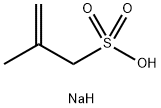3-Chloro-2-methylpropene
Synonym(s):ß-Methallyl chloride, 3-Chloroisobutylene;β-Methallyl chloride;3-Chloro-2-methyl-1-propene
- CAS NO.:563-47-3
- Empirical Formula: C4H7Cl
- Molecular Weight: 90.55
- MDL number: MFCD00000953
- EINECS: 209-251-2
- SAFETY DATA SHEET (SDS)
- Update Date: 2025-09-25 17:15:13

What is 3-Chloro-2-methylpropene?
Chemical properties
clear liquid
The Uses of 3-Chloro-2-methylpropene
3-Chloro-2-methylpropene has been used as reactant in the synthesis of cyclobutanone. It is used as an intermediate in the production of plastics, pharmaceuticals and other organic chemicals.
The Uses of 3-Chloro-2-methylpropene
In organic synthesis.
The Uses of 3-Chloro-2-methylpropene
3-Chloro-2-methyl-1-propene was used to study ring opening polymerization of oxirane derivatives using organotin phosphate condensate. It was used to study cationic polymerization of 3-Chloro-2-methyl-1-propene using using AICI3 and A3IBr, as initiators.
Definition
ChEBI: 3-Chloro-2-methylpropene is an organochlorine compound.
Biological Functions
MAC is a valuable index for clinical anesthesia, but it is seldom employed without taking other factors into consideration. For example, inhibiting movement in only 50% of patients is not acceptable. Consequently, if an inhalational agent were being used alone—that is, without the administration of other anesthetics or analgesic drugs—the anesthesiologist would employ a multiple of its MAC value to ensure immobility.MAC is frequently multiplied by a factor of 1.3 to achieve nearly 100% clinical efficacy. On the other hand, useful clinical results may be achieved with doses of anesthetics below MAC levels. For example, mild analgesia and amnesia often occur with doses of inhalational agents that are near 0.5 MAC. In this state, it may even be possible to communicate with patients intraoperatively, while their recall is limited.
Synthesis Reference(s)
The Journal of Organic Chemistry, 46, p. 824, 1981 DOI: 10.1021/jo00317a041
General Description
A colorless to straw-colored liquid with a sharp penetrating odor. Less dense than water and insoluble in water. Flash point below 0°F. May be toxic by ingestion. Irritating to skin and eyes. Used to make plastics and pharmaceuticals.
Air & Water Reactions
Highly flammable. 3-Chloro-2-methylpropene may react with water at elevated temperatures. . Insoluble in water.
Reactivity Profile
3-Chloro-2-methylpropene is sensitive to light. 3-Chloro-2-methylpropene can react vigorously with oxidizers. 3-Chloro-2-methylpropene is incompatible with strong bases. 3-Chloro-2-methylpropene may react with water at elevated temperatures. .
Hazard
Irritant; poison; anesthetic; questionable carcinogen; toxic.
Health Hazard
Inhalation causes irritation of nose and throat. Contact of vapor or liquid with eyes causes irritation. Liquid irritates skin. Ingestion causes irritation of mouth and stomach.
Safety Profile
Confirmed carcinogen with experimental carcinogenic, neoplastigenic, and tumorigenic data. Experimental reproductive effects. An irritant. Human mutation data reported. Very dangerous fire hazard when exposed to heat, flame, or oxidizers. Moderately explosive when exposed to heat or flame. Can react vigorously with oxidizing materials. To fight fire, use alcohol foam, CO2, dry chemical. When heated to decomposition it emits toxic fumes of Cl-. See also CHLORINATED HYDROCARBONS, ALIPHATIC; and ALLYL COMPOUNDS.
Carcinogenicity
3-Chloro-2-methylpropene is reasonably anticipated to be a human carcinogen based on sufficient evidence of carcinogenicity from studies in experimental animals.
Properties of 3-Chloro-2-methylpropene
| Melting point: | -80 °C (lit.) |
| Boiling point: | 71-72 °C (lit.) |
| Density | 0.925 g/mL at 20 °C (lit.) |
| vapor density | 3.12 (vs air) |
| vapor pressure | 102 mm Hg ( 20 °C) |
| refractive index | n |
| Flash point: | 9 °F |
| storage temp. | 2-8°C |
| solubility | H2O: insoluble |
| form | Liquid |
| color | Clear |
| explosive limit | 2.2-10.4%(V) |
| Water Solubility | 0.5 g/L (20 ºC) |
| Merck | 14,2148 |
| BRN | 878160 |
| CAS DataBase Reference | 563-47-3(CAS DataBase Reference) |
| IARC | 2B (Vol. 63, 115) 2018 |
| NIST Chemistry Reference | 1-Propene, 3-chloro-2-methyl-(563-47-3) |
| EPA Substance Registry System | 3-Chloro-2-methyl-1-propene (563-47-3) |
Safety information for 3-Chloro-2-methylpropene
| Signal word | Danger |
| Pictogram(s) |
 Flame Flammables GHS02  Corrosion Corrosives GHS05  Exclamation Mark Irritant GHS07  Environment GHS09 |
| GHS Hazard Statements |
H225:Flammable liquids H314:Skin corrosion/irritation H317:Sensitisation, Skin H411:Hazardous to the aquatic environment, long-term hazard |
| Precautionary Statement Codes |
P210:Keep away from heat/sparks/open flames/hot surfaces. — No smoking. P273:Avoid release to the environment. P280:Wear protective gloves/protective clothing/eye protection/face protection. P303+P361+P353:IF ON SKIN (or hair): Remove/Take off Immediately all contaminated clothing. Rinse SKIN with water/shower. P305+P351+P338:IF IN EYES: Rinse cautiously with water for several minutes. Remove contact lenses, if present and easy to do. Continuerinsing. |
Computed Descriptors for 3-Chloro-2-methylpropene
New Products
Indole Methyl Resin tert-butyl 9-methoxy-3-azaspiro[5.5]undecane-3-carboxylate Boc-His(Boc)-OH 2-CTC Resin 4-Chloro-7-tosy1-7Hpyrrolo[2,3-d]pyrimidine 5,7-Dibromo-1H-indole 2,5-dichloro-N-hydroxy-4,6-dimethylpyridine-3-carboximidamide 2,2-Dimethoxy-7-azaspiro[3.5]nonane hydrochloride 4-chloromethyl-5-methyl-1,3-dioxol-2-one (DMDO-Cl) R-2-BENZYLOXY PROPIONIC ACID 1,1’-CARBONYLDIIMIDAZOLE 1,1’-CARBONYLDI (1,2-4 TRIAZOLE) N-METHYL INDAZOLE-3-CARBOXYLIC ACID 4-((2-hydroxyethyl)thio)benzoic acid 1-(TERT-BUTOXYCARBONYL)-2-PYRROLIDINONE Methyl 6-methylnicotinate 3-Pyridineacrylic acid tert-Butyl carbazate TETRAHYDRO-2H-PYRAN-3-OL 2-((4-morpholinophenylamino) (methylthio) methylene) malononitrile 3-(4-morpholinophenylamino)-5-amino-1H-pyrazole-4-carbonitrile 2,4-dihydroxybenzaldehyde 1,3-Diethyl-1,3-Diphenylurea Methyl 2-methylquinoline-6-carboxylateRelated products of tetrahydrofuran







![2-[[(2-ethylphenyl)(2-hydroxyethyl)amino]methyl]-3,3-difluoro-Propanenitrile](https://img.chemicalbook.in/CAS/GIF/2647-14-5.gif)
You may like
-
 Methallyl chloride, 97% CAS 563-47-3View Details
Methallyl chloride, 97% CAS 563-47-3View Details
563-47-3 -
 3-Chloro-2-methyl-1-propene (stabilized with Stearyl 3-(3,5-Di-tert-butyl-4-hydroxyphenyl)propionate) CAS 563-47-3View Details
3-Chloro-2-methyl-1-propene (stabilized with Stearyl 3-(3,5-Di-tert-butyl-4-hydroxyphenyl)propionate) CAS 563-47-3View Details
563-47-3 -
 3-Chloro-2-methyl-1-propene CAS 563-47-3View Details
3-Chloro-2-methyl-1-propene CAS 563-47-3View Details
563-47-3 -
 Pyridine 99.5% HPLC /UV SpectroscopyView Details
Pyridine 99.5% HPLC /UV SpectroscopyView Details
110-86-1 -
 Piperazine Spot supply, best priceView Details
Piperazine Spot supply, best priceView Details
110-85-0 -
 Dibutyl PhthalateView Details
Dibutyl PhthalateView Details
84-74-2 -
 Imidazole Spot supply, competitive priceView Details
Imidazole Spot supply, competitive priceView Details
288-32-4 -
 Thiourea 99% ARView Details
Thiourea 99% ARView Details
62-56-6
